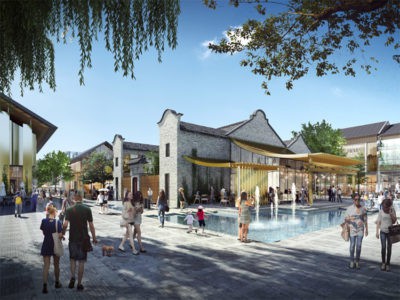
The Ningbo project weaves new spaces into a traditional canal community
A coastal district in one of China’s oldest cities is in the midst of a decade-old redevelopment effort that illustrates the challenges, and opportunities, involved in transforming an urban area built along a network of canals beginning as far back as 2,000 years ago to meet the needs of the 21st century.
Zhenhai district in Ningbo was once a walled city, and later part of one of China’s largest treaty ports, but the town whose waterways once fed into the Eastern Zhejiang canal leading to Hangzhou had seen much of its historic character papered over by ramshackle development in the 1970s and 1980s.
Now, in the latest stage in the historic district’s recovery, one of China’s largest developers has appointed global design firm Benoy to provide a masterplan and to act as architects for a mixed-use destination along the banks of ancient city’s canals to weave new functions into the traditional location.
Creating a New Destination in a Historical Site
For the project in the second-largest city in eastern China’s Zhejiang province, developer Sino-Ocean Land has given UK-based Benoy a brief to create a combined retail, office and cultural complex that preserves the heritage of the two millennium-old community, while helping it prepare to meet the needs of one of China’s most vibrant local economies.

Benoy senior associate director Hao Li
“Ningbo is steeped in history and we are incredibly proud to be working on this special regeneration project. As designers, we are excited to work on something that will be part of the evolving city – creating a vibrant new destination nestled amongst a historical site,” said Hao Li, a senior associate director at Benoy who helped to design the project for developer Sino-Ocean Land.
The 140,000 square metre complex keeps heritage at its heart as it brings together hospitality, co-working spaces, cultural facilities and a rejuvenated public park at the waterfront site near Ningbo’s port.
“It was important for us that we preserve the importance of the historical structures because of the story of Ningbo,” Li explained. “The city’s character is embedded in its 1,300 years of historical importance in merchant culture, and the site itself contains a number of traditional residential buildings which once housed the wealthy families of those merchants.”
Weaving the New into the Old
The design for the project retains the original forms of the historical buildings on the site, with Benoy opting to insert new blocks through the development which form spaces for pedestrian thoroughfares, retail and cultural events.
“The buildings have not only been restored but they have also been injected with modern functional space. Capturing this essence is important as it forms a sustainable blueprint of heritage preservation that extends beyond the brick and mortar,” Li said.
By interweaving new buildings into the complex in Ningbo’s traditional canal district, Benoy was able to preserve the local views of the historical structures along the banks of the waterways while creating new assets which could provide scale and infrastructure for a city that now supports a population of more than eight million people.
“Urban renewal in China is an opportunity to not only give the place a new identity that blends the east with west, but also provides an opportunity to create social spaces that have economic, social and environmental benefits for the people,” Li pointed out. “With that in mind, the broken maze of narrow streets, alleyways, courtyards are carefully weaved into new streets and plazas as a way of offering a meaningful retail experience within an enriched heritage mixed use district.”
The redevelopment of the canal area of Zhenhai district is part of an urban renewal effort that has been going on in this area of Ningbo since 2010, with the local government keen to replace 1970s and 1980s vintage buildings with more modern projects that can both accommodate the needs of a city whose per capita GDP of $16,468 ranks just a notch below Shanghai’s $16,524.
Bringing Experiential Retail to an Ancient Waterfront
While Ningbo’s commerce once took place on small boats floating down the canal, the city’s current residents are opting for more comfortable environments while still hoping to retain reminders of the old ways.
To create this new retail experience, Benoy, which has now handled more than dozens of projects in Greater China, designed a centre for experiential shopping which turns the waterfront site into an axis of the past and future, injecting new programs for interacting with the latest offerings from global and local brands.
“In the midst of a fast changing retail environment in China, Chinese customers have become increasingly sophisticated in the way they shop,” Li said. “Instead of an international or purely western environment, they are looking deeper into their roots and are looking for a more personalized space that encapsulates the local spirit.”
To accomplish this blending of old with new and East with West, Benoy is relying on its experience with creating some of China’s best known commercial and cultural destinations, including a project currently under development slightly further up the Yangtze delta in Nanjing.
In the capital of Jiangsu province, Benoy’s designers have been busy reimagining a 100-year-old former ice processing facility in Nanjing for a $2 billion retail hub within a 236-hectare urban renewal project.
“The success of the conservation effort is highly dependent on the compatibility between the urban modernization and historic conservation,” Li said. “Similar to MCC Nanjing, in Ningbo we have worked with the community to make sure the project serves local needs, including opening a dialogue with local organisations to improve recognition for heritage projects.”
Expanding a Mainland Portfolio
Not all of the company’s China portfolio is historic, however, with the UK firm having designed the IFC mall in Shanghai, as well as the Gala Avenue Westside project just up the road from that Pudong landmark.
During 2017, Benoy’s Parc Central project in Guangzhou won a gold award for “Design and Development Excellence” among new developments at the International Council of Shopping Centers (ICSC) Asia Pacific Shopping Center Awards, and now in Ningbo the company looks forward to helping Sino-Ocean Land to bring an experiential retail hub to one of China’s most historic port cities.
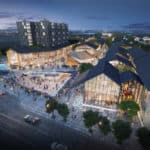

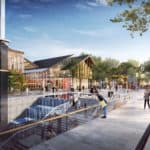


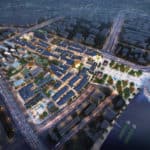
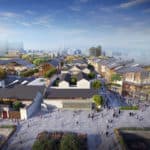
Leave a Reply